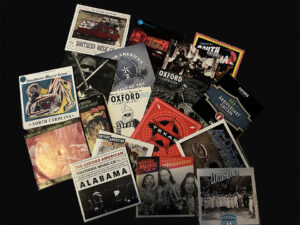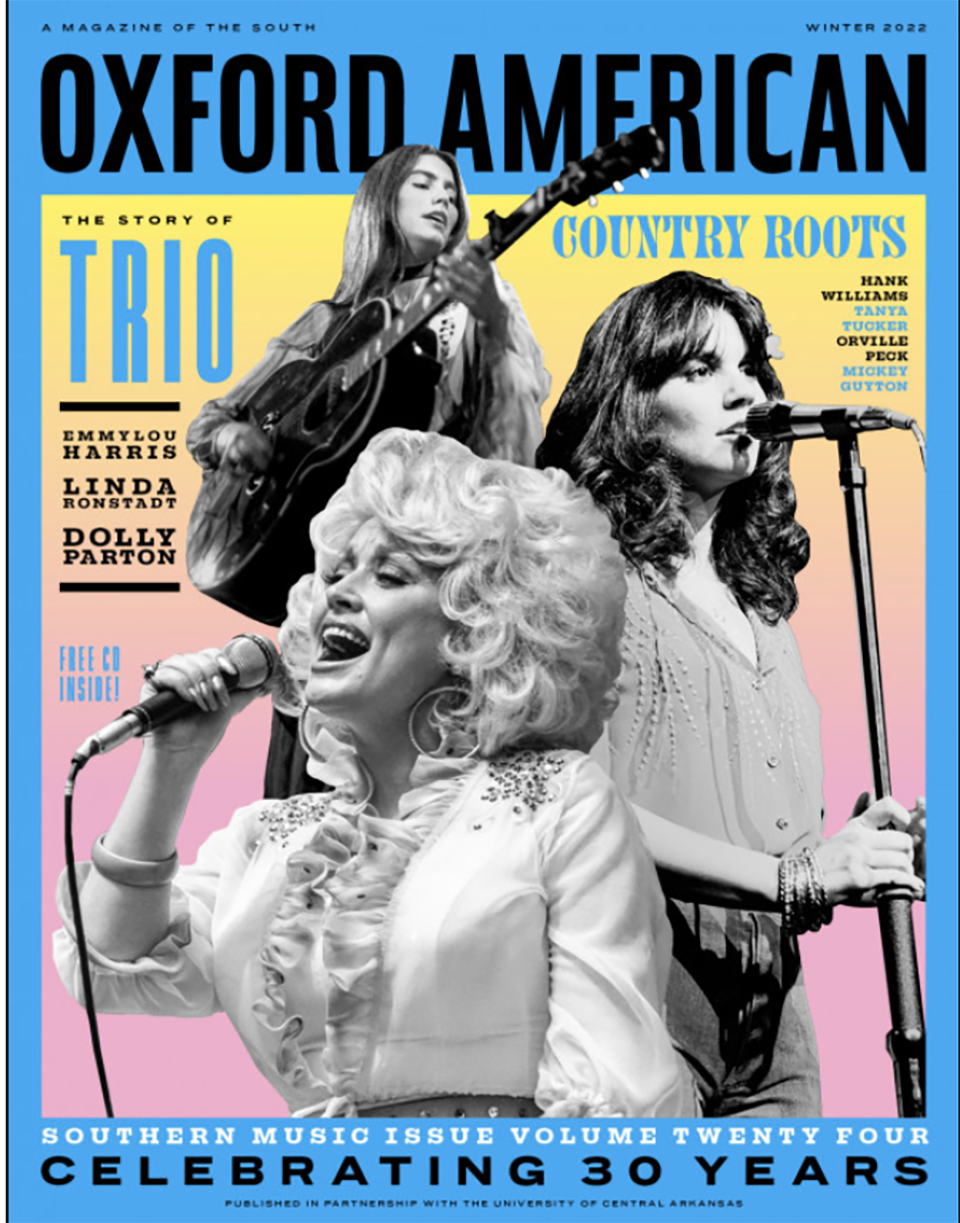In a time when some people question the future of print journalism, Oxford American magazine has enjoyed a year-long celebration of the 30th anniversary. A perennial favorite of readers, the music issue hit the shelves this month with a focus on “Country Roots.” Editor Daniel A. Jackson knows not to take a single issue for granted, particularly as other publications dedicated to strong prose have announced they are closing their doors.

“I have an immense amount of gratitude for the audience–the readers and the folks who click on the website. Every little bit matters,” she said.
And while, as a nonprofit, as a part of their mission, OA makes all their content accessible to anyone with an Internet connection, Jackson says, “We aim to make it an art object that you can hold in your hands and live with, as well as an archival document.”
Little wonder, then, that Oxford American readers hold on to their issues or the CDs that accompany the annual music issue. Jackson says, “I think that the Oxford American has always done a good job of reflecting its editors’ and writers’ obsessions at any given moment. It has always been sincere, and that comes through to people. We’ve always been people who care about the region and get obsessed about a song or a piece of art or a recipe or a funny story we heard while at brunch with our mom.”
Likewise, she says, the magazine’s team likes to follow readers’ obsessions; the genuine curiosity and care in presentation comes across as well. “No sentence goes untouched,” she said, “and the art team spends hours thinking about each individual piece and rooting through the entirety of their experience to present a writer’s story as beautifully as it could be.”
Jackson says she loves the form of a magazine: “It’s a record at any given time, and also because it’s a periodical, we have another opportunity to improve what we did.”
The writing in the “Country Roots” issue is particularly rich in its variety. Oxford American has covered country music many times, “probably in almost every music issue and even outside of music issues,” Jackson admits. The words “country roots” keep surfacing.
“I knew that I wanted a prismatic look at the sound–in the past tense and present and future thinking–and then I wanted all of those threads somehow to come together.” She and the editorial team considered what they could add to the conversation. They wanted to explore the essence of country sound, to ask what makes country country? Is it a sound? Is it a lyric? Is it a certain kind of storytelling?
In the prose and the poetry that came together for the issue, common threads emerged. Josina Guess explored “That High Lonesome Sound” produced by a thana, a form of Korean harp created and played by Mya Thay, who brought the instrument from Myamar that produced a sound that was at home in the foothills of the southern Appalachian mountains. In a separate piece, “Once Upon a High Lonesome,” Holly Haworth wrote of listening for the elusive call of the whippoorwill. In David Ramsey’s feature “I Ain’t Got Nothing But Time” on the “mostly true legend of Hank Williams” the “lonesome whippoorwill” turns up again.
Some of the stories came directly from the prompt provided in the call for submissions, asking for example about “ambient sounds like the bird calls that are in so many country songs.” Writers were also prompted to consider what Jackson called “the founding fathers and the founding mothers of country music,” who have “become these archetypes that we kind of continue to see.”
In that quest for the past, present, and future of country music, the music issue not only crossed timelines but also recognized the diversity that has always been at the roots of the genre, even when less visible. This issue includes a conversation with Mickey Guyton and a feature by Imani Perry on “The Country Idiom of Hip-Hop.” In “Her Rightful Place,” Jason Kyle Howard offers a look at Tanya Tucker, whose career has experienced a second life.
The magazine cover features Emmylou Harris, Linda Ronstadt, and Dolly Parton, whose Trio albums are discussed in the “Songbook” section of the issue, which gives brief looks at a variety of country performers. It includes pieces about such performing artists as Solange, Millie Jackson, Patsy Cline, and the Pointer Sisters and others written by Gretchen Peters, Rodney Crowell, and Rissi Palmer.
During her first year as editor-in-chief, Jackson discovered that every past issue had a theme, but in the last year, the editorial team opted to have no themes except for the music issue. They wanted to identify writers’ concerns and to glean from what the market told them “rather than dictating to writers and artists,” but, she said, “writers tended to converge on similar ideas and themes and preoccupations naturally. It seems like Hank Williams was on a number of people’s minds.”
In exploring the roots of country music, Oxford American demonstrates that the genre is much more than what is playing on country radio. The magazines represents both a balance of ethnicity and a balance of time. Digging deeper to into the origin of country music, they show a picture of how much broader country music has become.
“I would wager maybe it was always that broad,” said Jackson. “The marketing mechanism of American record companies had to create of categories in order to bring the music to market, but I would argue that from its inception, it’s always been broad and cosmic, cosmopolitan, multicultural, international at the root. It’s thrilling for me to think about the music in that way because so much has happened to obscure those roots, some of it unintentionally, some of it very deliberately, like an etching revealing just how complex and vibrant it always has been.”
Exploring those complexities has served to welcome readers to the pages who have felt marginalized. The piece on Tanya Tucker addresses the huge disparity between the number of male and female artists inducted into Country Music Hall of Fame, despite how many women artists were formative to the genre, starting with the Carter Family but extending far beyond that point.
“I like opening up and having those conversations about how people have been deliberately marginalized, but my aim was also just to tell the truth on the page and to show how it doesn’t have to continue to be that way,” said Jackson. A case in point was the story of the initial reception when the Pointer Sisters first played the Opry. As one of the first Black acts to headline the Ryman, they first met with startled surprise from audience members who didn’t see them as the faces of country music—until they opened up with “Fairy Tale,” winning the crowd’s approval. Their parents had moved from rural Arkansas to Oakland, California, where their daughters because city girls; however, they grew up on country music radio, steeped in that kind of music and those sounds. Their recordings included a cover of Conway Twitty’s “Slow Hand,” and Steely Dan’s “Dirty Work,” with a decidedly country sound.
Listening to their readers, the editorial staff of OA also recognized that, even in a digital age, readers want the CD sampler that accompanies the music issue. The nineteen tracks on this year’s CD range from traditional, such as “Where Can I Go (But to the Lord)” by Brother James Anderson and Hank Williams’ version of “Farther Along” to such classics as “Wildflowers” from Trio and more modern and diverse cuts by Margo Price, the Drive-by Truckers, Mickey Guyton, and Rhiannon Giddens.
One of the enjoyable parts of the job of editor for Jackson is developing the prompt for the call for submissions for upcoming issues. For the “Country Roots” issue, the prompt was inspired by a poem by Nikki Finney, who wrote about her experience as a black woman from Appalachia, by Alice Randall’s story in last year’s music issue, in which she talked about Louis Armstrong playing on one of the earliest commercial country recordings by Jimmie Rodgers, and by Tina Turner, whose first solo album released in 1974 was Tina Turns the Country On!
As Jackson considers what comes next, she recognizes that many ideas emerge organically. She quoted Memphis poet Jamie Hatley, who said, “Out of the work comes the work.” The decisions are never unilateral, she said, adding, “I like to be edited by my team.” The coming year will bring another music issue. She says the magazine also plans to go back to issues that focus on individual Southern states.
“There’s a real hunger for us to cover the states that we haven’t covered yet, so that’s high on the list of considerations, but it’s not just an editorial decision. The business team weighs in, and what people say they want matters—the audience, the readers.” Eventually, they will cover all of the Southern states. She expects to circle back to some themes that have been explored in past years, focusing on Southern films and food, with prompts expected in the spring.
“I’d like to find the perfect balance between doing issues with the theme and issues that are general issues,” Jackson said. She will continue to strike a balance between fiction and nonfiction, poetry and prose, with carefully curated art and photography.
Even the point of view requires a balance. “I like for our stories in each issue to hit on different registers and all have like different points of view,” she said. “People take these songs so personally and they’re so connected to early memories, so the music issue lends itself towards more first person writing than a general issue, but we definitely wanted to have subjective kind of reported stories.” She noted the mixture of “real straight ahead writing” and construction of scenes from the close third person, in addition to first person accounts. Recognizing the oral tradition of the region as part of our country roots, Jackson said that she felt all the writers aimed to approximate the richness of oral storytelling.
While the editorial team faces quarterly print deadlines, they continue to update online content. Their Points South podcast took the show on the road in September. Alice Randall moderated an event in Nashville with artist Jodi Hays and singer-songwriter Margo Price; in Durham, NC, Jackson conducted conversations with Jenn Wasner of Flock of Dimes and artist Clarence Hayward; and in Bentonville, AR, songwriter Buffalo Nichols was joined by artist Oluwatobi Adewuni and University of Arkansas Black Student Caucus spokesperson Tyrah Jackson.
As the online presence has grown, it includes pieces supplemental to the print magazine, along with other stand-alone features. Jackson projects more playlists and audio storytelling in the digital space.
Through an additional outreach, the magazine provides print copies to a number of prison libraries and reading programs, says Jackson, “so our audience is inside as well as outside in the world.” They also offer special subscription pricing for university MFA programs.
All of these efforts fuel what Jackson considers the point of the magazine: to create a call and response between writers and the editors, but also to build a community with readers, so Oxford American becomes more than words on a page.
https://oxfordamerican.org/magazine/issue-119-winter-2022

